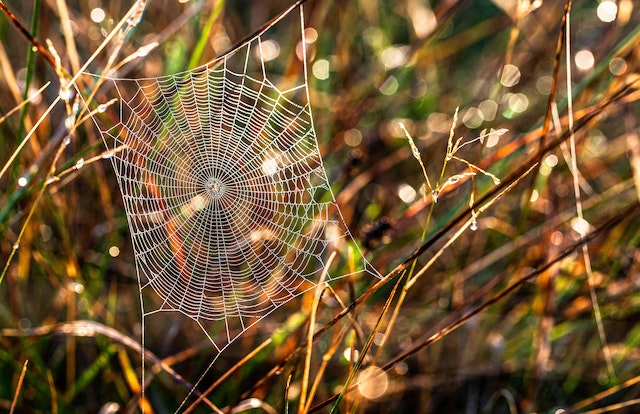
How do spiders make webs? By producing silk from their bodies and weaving it into a strong web. There are two parts to this question: how do spiders produce silk and how do they make their webs. Let’s look at how they make silk first.
Spiders are able to produce silk from their bodies. There are several insects that have the ability to do this but spider silk has several attributes that make it perfect for web building. It is extremely strong. Pound for pound, it has a higher tensile strength than steel, which means that they can support a lot of weight. Webs vary by species, but they can hold about 170 times the weight of the spider, in general. Spider silk is extremely thin and light. The silk for the web is about 3 micrometers wide. The web can stretch a lot, which means it won’t break in the wind or when an insect flies into it. And, of course, the webs are very sticky.
So, how do spiders produce the silk? Spiders have silk glands inside them. The silk is not stored ready-made inside the spider, but produced on demand. These silk glands are a little like balloons in shape with a very long and thin neck. At the end of the neck is a valve and a spinneret. The cell walls of the glands secrete proteins and these proteins mix with water and start to join together into chains. The long chains of proteins are what gives spider silk its strength. There are also smaller chains, which give the silk its flexibility. Once the proteins are joined together, they are pushed along the neck of the gland and more proteins coat the surface of the silk. The silk goes along the neck, becoming narrower, until it exits through the valve. It varies from species to species but spiders have many glands that all produce silk. When the liquid protein and water silk exits the valve, it hardens on contact with air. Spiders have six to eight spinnerets which take the silk as it comes out of the valves and spin it into the silk that the spider will use. The spider can pull the silk out with its back legs or it can pull it out by using gravity. Spiders very rarely run out of silk because as long as they can eat protein and drink water, they can make silk. Sometimes they eat their old webs to get the proteins.
Spiders can produce many different types of silk and they use it for many functions. Not all spiders actually make webs. There are many spiders that hunt on the ground. Spiders also use their webs to hide in. Jumping spiders make little tunnels of silk and they spring out of them when prey passes. Spiders use their silk to fasten their eggs to surfaces. Some spiders make a kite out of silk and use it to float through the air. Many spiders also use silk to immobilize prey.
So, how do spiders make webs? Like many things, the first step is the hardest. Spiders need to make their webs across a gap, so the first step is to get a line of silk across that gap. Spiders can produce sticky and non-sticky silk. To bridge the gap, they reel out a long line of sticky silk and release it into the wind. The wind carries it away and the silk will catch on something. The spider feels the vibrations when the silk has caught on something and reels the end of the line in until it is tight. Spiders might do this more than ten times until they get a line that crosses where they want it to. They will eat all of the silk strands that they don’t need. The spider walks out along the line, spinning more silk to strengthen it. Then the spider makes two lines out from the center of the first line to the sides of the gap, making a Y shape. Once this is done, the spider can go ahead and spin the rest of the web. They start on the outside and work their way inwards. When they have finished they spin more lines to strengthen the web and they are done.
Spiders sometimes sit and wait in the center of their web for prey to get trapped, but they are an easy target for birds if they do that. Quite often, they hide at the side with one of their feet on a line from the center of the web. They can feel any vibrations if prey lands and head out to get it. Spiders are also able to move very quickly on their own webs. This is not because they don’t get stuck. It is because they spin sticky and non-sticky silk lines and they know which is which. They run around on the non-sticky ones and insects get stuck to the sticky ones. And this is what I learned today.
Photo by Marina Arcady: https://www.pexels.com/photo/photograph-of-spider-web-13633947/
Sources
https://animals.howstuffworks.com/arachnids/spider3.htm
https://www.nhm.ac.uk/discover/what-are-spider-webs-made-of.html
https://www.assuredenvironments.com/blog/how-do-spiders-choose-where-to-spin-their-webs
https://www.hamiltoncaster.com/Blog/EntryId/2099/Why-spider-silk-is-stronger-than-steel
https://en.wikipedia.org/wiki/Spider_silk
https://en.wikipedia.org/wiki/Spider_web
